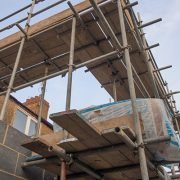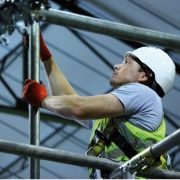Scaffolding Safety Tips for Winter
Winter is now here and the memories of working in the sunshine of the summer months are unfortunately behind us. Gone are the days of making sure you have enough sun cream and ensuring you are fully hydrated, as we now embark on a harsher climate.
There are, at this time of year, risks within the scaffolding industry that we need to look at and take care of. Scaffolding hazards don’t vanish, they just change as our weather and environment do too.
Our focus on preventing risks and accidents needs to change also. As the days get colder, the air quality changes and there are new challenges to account for that we need to put measures in place to secure the safety of our staff and colleagues.
Here are five scaffolding safety tips that all of us in the industry can be aware of this Winter:
1) Monitor and keep an eye on the weather:
Keeping an eye on the weather may be obvious but it is hugely important.
The resulting weather of snow, ice, rain, wind and the cold can result in tougher working conditions for all staff but also can cause icy and wet surfaces, unstable scaffold structures and falling objects.
Procedures can be put into place to help, including marking icy or wet surfaces and protecting staff and the public from falling objects by using netting, barricades, shrink wrap and toe boards.
Equip your staff with the correct PPE to protect them from the colder days with fleeced jackets, warm hats and gloves, with hard hats also being worn.
Scaffolding staff should also never be expected to work in extreme or dangerous weather conditions that could result in accidents or injuries.
2) Increase your safety and health checks and procedures:
Take time to check the scaffolding complexities of working on a winter’s day.
Increase your safety inspection checks on all of your scaffolding equipment, remind your staff often about the added risk to the job in adverse conditions and look at surfaces and determine areas where you can alleviate risk by wiping down or cleaning any excess snow, ice, sleet rain or mud.
Scaffolders are working outside for extended periods of time so never take anything for granted and keep an eye on your staff and their well-being.
3) Making sure that everyone is visible
As the winter weather kicks in, the scaffolding industry staff will potentially work long periods without sufficient natural light, which can provide a multitude of risks.
Alleviating these problems is essential by making staff visible by equipping them with Hi-Vis vests.
To make any working areas more visible you can try adding spotlights or torches to these areas so that everyone can be safe and also seen.
4) Take regular breaks:
Working in the harsh winter weather can be tough on the mind and the body, so offering a few extra breaks could increase the overall productivity, effectiveness, safety and morale of the staff.
5) Extra hazard safety precautions:
Executing additional safety procedures can minimize any hazard potential on-site.
To reduce the risks, management and staff can take the following measures to help the situation:
- Providing additional PPE and equipment, such as scaffold harnesses
- Increasing staff health and safety training and development
- Making sure that the footwear of the staff is suited for the winter weather conditions
- Providing tea, coffee and hot, heavy meals that increase your body temperature
In summation, hopefully, employers and staff themselves will take a sensible approach to working in the winter weather to ensure the safety of all those within the scaffolding industry.
For any scaffolders who have suffered a mishap, The Lighthouse Club is there to provide any support or guidance that you may need.





